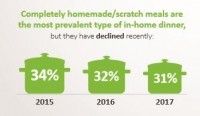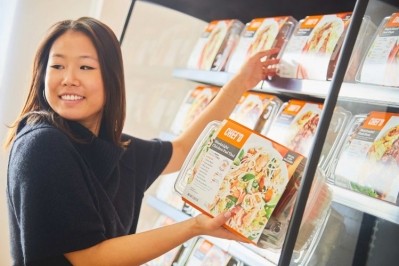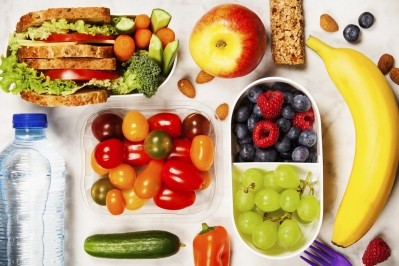The NPD Group: Every consumer has one problem right now, and that is ‘what’s for dinner?’

“The opportunity for whether you’re a food retailer or foodservice provider, is figuring out what are the problems that I can solve? Every consumer has one problem right now, and that is ‘What’s for dinner?’,” Portalatin told FoodNavigator-USA.
Convenience redefined
When looking at the types of meals consumers are preparing in their home kitchens, ‘completely homemade/scratch meals’ are the most prevalent type of in-home dinner, but that has decreased in recent years as consumers start to look for more convenient prepping methods.
“The word convenience is being redefined. How we access that convenience is changing,” Portalatin said.
Convenience used to be defined as outsourced solutions such as heading to a restaurant for dinner or take-out, now consumers want to be provided the tools to control what goes into their meal but in a way that is not time consuming.
And for many consumers, 30-45 minutes of prep – the approximate time some meal kits promise to have dinner on the table – is too much of a commitment.
“We’ve got to think about what is the definition of that 30 minutes and how is it being spent?”
For younger boomers (aged 53 to 61 in 2017), dinners that take less than 10 minutes are very important, accounting for one-fourth of all their in-home dinner meals. This is expected to grow about 8% over the next five years, according to NPD Group.
Half an hour spent chopping and sautéing vegetables isn’t that appealing to many people, according to Portalatin.
Therefore, some consumers have turned to new time-saving gadgets such as the Instapot, a user-friendly, multi-use pressure cooker that can cook rice, steam and sauté, or hard boil eggs in minutes, he said.
The renaissance of the frozen food category is also responding to this trend of consumers wanting control over the authenticity of ingredients that go into their meals but with a relatively convenient approach, Portalatin added.
“Frozen foods manufacturers are coming to market with products that understand that trend and use it to give consumers a path to pure food.”
Are meal kits the solution?
On paper, meal kits seem to be directly answering the consumer’s dinner conundrum but many have struggled with repeat online orders, and started aggressively targeting in-store retail as well.
According to Portalatin, the most unique feature of meal kits when they came on the scene was the online subscription model and leveraging e-commerce. But since that hasn’t proved to be the right solution for many, some firms have had to adjust their strategies.
“A lot of consumers are finding their supermarket retailer are also taking this solutions approach,” he said. “I think from the traditional meal kit perspective, the retailer is in a really great position to be that solutions provider.”
Rise of ‘blended meals’
Even though 80% of dinners in the US are prepared and consumed in the home, foodservice spending has increased, up 2% in the year ending May 2018, NPD Group noted.
US consumers might not be dining out as much, but they do turn to foodservice for a shortcut in their in-home meal preparation, creating what Portalatin refers to as “blended meals.”
Close to half of dinners purchased from a restaurant are consumed at home and a growing number of in-home meals are a blend of dishes prepared and items purchased ready-to-eat from a foodservice establishment, according to NPD. “Blended meals” are set to grow steadily over the next five years.
The foodservice industry can stand to benefit from the at-home meal trend by being the go-to for one or two components of a meal for the consumer such as a prepared chicken or side dish.
Portalatin added that the center of the store also has an important role to play in the concept of blended meals by providing unique spice blends and marinades made from natural ingredients for shoppers looking to replicate bold, ethnic flavors.
“We’re not going to become Michelin-starred chefs any time soon, but we are seeing more solutions come in a bottle [such as sauces and marinades].”

















